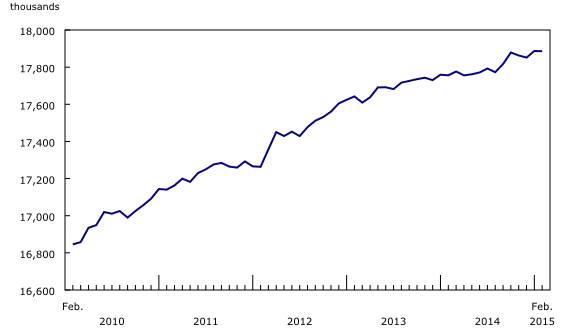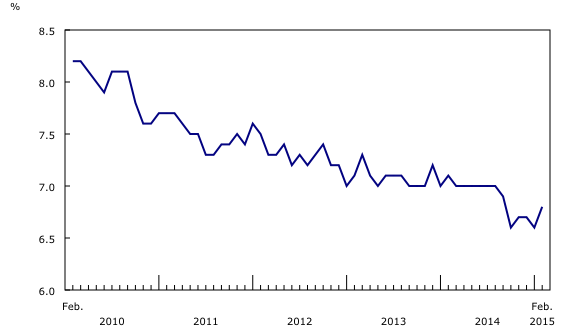Labour Force Survey, February 2015
Archived Content
Information identified as archived is provided for reference, research or recordkeeping purposes. It is not subject to the Government of Canada Web Standards and has not been altered or updated since it was archived. Please "contact us" to request a format other than those available.
Released: 2015-03-13
Employment was unchanged in February, while the unemployment rate rose by 0.2 percentage points to 6.8% as more people searched for work.
In the 12 months to February, employment increased by 130,000 (+0.7%) with most of the growth in the second half of the period.
Compared with February 2014, full-time employment rose by 121,000 (+0.8%), while there was little change in part-time work. Over the same period, the total number of hours worked was up slightly (+0.2%).
In February, employment increased among men aged 55 and older, while there was little change in the other demographic groups.
Provincially, employment declined in Alberta, Nova Scotia and Newfoundland and Labrador, while it increased in Quebec.
There were fewer people working in manufacturing; natural resources; information, culture and recreation; as well as in 'other services.' However, there were gains in construction and educational services in February.
The number of public sector workers increased in February. There was little change in the number of private sector employees and the self-employed.
Adjusted to the concepts used in the United States, the unemployment rate in Canada was 5.9% in February, up 0.3 percentage points compared with January. At the same time, the US unemployment rate declined 0.2 percentage points to 5.5%.
More employed men aged 55 and older
There were 17,000 more men aged 55 and older working in February and their unemployment rate was 6.3%. Employment for women in the same age group was little changed. However, their unemployment rate rose by 0.4 percentage points to 5.2% as more of them were searching for work.
While youth employment was virtually unchanged in February, their unemployment rate rose 0.5 percentage points to 13.3% as more youths looked for work.
For men and women aged 25 to 54, employment was little changed in February. However, the unemployment rate for men went up 0.5 percentage points to 6.1% as more of them searched for work. The unemployment rate for women in this age group was 5.1% in February, down 0.2 percentage points from the previous month.
In the 12 months to February, most of the increase in employment was among men aged 25 and older, up 91,000 or 1.1%. These gains were entirely in full-time work.
Provincial summary
Employment in Alberta fell by 14,000 in February, pushing the unemployment rate in the province up 0.8 percentage points to 5.3%, the highest since September 2011. Employment losses were in a number of industries, most notably retail and wholesale trade; natural resources; professional, scientific and technical services; as well as manufacturing. In the province's natural resources sector, employment has decreased by 20,000 (-11.0%) since the most recent peak in September 2014.
In Nova Scotia, employment fell by 4,400 and the unemployment rate increased 0.7 percentage points to 9.1%. Despite fewer people working in February, employment in the province was virtually unchanged on a year-over-year basis.
Employment in Newfoundland and Labrador declined by 3,000 in February, bringing losses over the past 12 months to 6,900 (-2.9%). In February, the unemployment rate in the province increased by 1.2 percentage points to 12.6%.
In Quebec, employment increased for the second consecutive month, up 17,000 in February and all in part-time work. In the 12 months to February, overall employment in the province increased by 44,000 or 1.1%. Despite more employment in February, the unemployment rate remained at 7.4% as more people participated in the labour force.
In Ontario, gains in full-time employment were largely offset by declines in part-time work, leaving overall employment little changed. The unemployment rate in the province remained at 6.9%. Compared with a year earlier, employment increased by 39,000 or 0.6%.
Employment in the remaining provinces was little changed between January and February.
Industry perspective
The number of people employed in manufacturing fell by 20,000 in February, the first decline since August 2014. The bulk of the losses in February occurred in Ontario and Alberta.
Employment in natural resources decreased by 17,000 in February, bringing losses over the past two months to 26,000 (-6.8%). Most of the declines for the month were in British Columbia and Alberta.
The number of people employed in information, culture and recreation declined by 12,000 in February. Compared with 12 months earlier, employment in this industry was little changed.
In February, employment declined by 12,000 in 'other services' industries, such as repair and maintenance, bringing losses over the past 12 months to 44,000 (-5.5%).
More people were working in construction in February, up 16,000, bringing gains over the past 12 months to 56,000 (+4.1%).
Employment also rose in educational services (+15,000) in February. Compared with 12 months earlier, employment in the industry increased by 61,000 or 5.0%.
Between January and February, the number of public sector employees rose by 24,000, while there was little change in the number of private sector employees and the self-employed.
On a year-over-year basis, self-employment grew by 60,000 or 2.2% and the number of public sector employees was up by 43,000 or 1.2%. Over the same period, the number of private sector employees was little changed.
Canada–United States comparison
Adjusted to US concepts, the unemployment rate in Canada was 5.9%, while the rate in the United States was 5.5%. Compared with February 2014, the unemployment rate in Canada edged down 0.1 percentage points, while the US rate fell by 1.2 percentage points.
In February, the employment rate in Canada (adjusted to US concepts) was 62.0%, compared with 59.3% in the United States. On a year-over-year basis, the employment rate declined by 0.2 percentage points in Canada, while it increased by 0.5 percentage points in the United States.
Note to readers
The Labour Force Survey (LFS) estimates for February are for the week of February 15 to 21.
The LFS estimates are based on a sample and are therefore subject to sampling variability. As a result, monthly estimates will show more variability than trends observed over longer time periods. For more information, see "Interpreting Monthly Changes in Employment from the Labour Force Survey." Estimates for smaller geographic areas or industries also have more variability. For an explanation of sampling variability of estimates and how to use standard errors to assess this variability, consult the "Data quality" section of the publication Labour Force Information (Catalogue number71-001-X).
This analysis focuses on differences between estimates that are statistically significant at the 68% confidence level.
The employment rate is the number of employed persons as a percentage of the population 15 years of age and over. The rate for a particular group (for example, youths aged 15 to 24) is the number employed in that group as a percentage of the population for that group.
The unemployment rate is the number unemployed as a percentage of the labour force (employed and unemployed).
The participation rate is the number of employed and unemployed as a percentage of the population. For more detailed information, see the Guide to the Labour Force Survey (Catalogue number71-543-G).
Seasonal adjustment
Unless otherwise stated, this release presents seasonally adjusted estimates, which facilitates comparisons by removing the effects of seasonal variations. For more information on seasonal adjustment, see Seasonally adjusted data – Frequently asked questions.
Sample redesign
Every 10 years, the LFS undergoes a sample redesign to reflect changes in population and labour market characteristics, as well as new definitions of geographical boundaries. The redesigned sample was introduced starting in January 2015 and will be fully implemented by June 2015.
A more detailed summary, Labour Force Information (Catalogue number71-001-X), is now available for the week ending February 21. From the Browse by key resource module of our website under Publications, choose All subjects then Labour.
Summary tables are now available online. From the Browse by subject module of our website, choose Labour.
The next release of the Labour Force Survey will be on April 10.
Contact information
For more information, contact us (toll-free 1-800-263-1136; 514-283-8300; infostats@statcan.gc.ca).
To enquire about the concepts, methods or data quality of this release, contact Vincent Ferrao (613-951-4750; vincent.ferrao@statcan.gc.ca) or Andrew Fields (613-951-3551; andrew.fields@statcan.gc.ca), Labour Statistics Division.
- Date modified:



